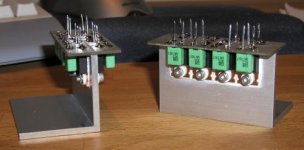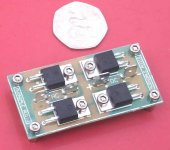I was thinking of making my own bridges out of the fast recovery diodes (which ones, I don't know... any suggestions?). Has anyone tried to make their own bridge packs by potting them so they can be easily heatsink mounted? Anyone have a good idea how to heat sink these diodes?
Steve
Steve
Attachments
I gave this some thought a while ago. For axial leaded diodes you might consider drilling four holes through a rectangular piece of copper bar stock. Just large enough to guarantee that the diodes will be potted without any voids. Be sure to also drill and tap (at least) two holes for mounting it. As for the adhesive, JB Weld can handle the temperature, but I'm sure there are more thermally conductive options available. FWIW, there are diodes in TO-220 packages too.
UG10DCT
The UG10DCT from General Semiconductor, available from Mouser Electronics, works well. There are 2 diodes in each to220 package and a bridge can be made with 3 parts.
George
The UG10DCT from General Semiconductor, available from Mouser Electronics, works well. There are 2 diodes in each to220 package and a bridge can be made with 3 parts.
George
nobody special said:I was thinking of making my own bridges out of the fast recovery diodes (which ones, I don't know... any suggestions?). Has anyone tried to make their own bridge packs by potting them so they can be easily heatsink mounted? Anyone have a good idea how to heat sink these diodes?
Steve
Hi Steve,
I was thinking about something like this with for MSR1560 for my Ampzilla:
😉
Attachments
All good ideas! Thanks!
I really like the idea with the copper bar stock. Anyone have any ideas about which diodes to use, and what package they come in?
Thanks for the link, Peter. Sorry for the redundant posting.
Steve
I really like the idea with the copper bar stock. Anyone have any ideas about which diodes to use, and what package they come in?
Thanks for the link, Peter. Sorry for the redundant posting.
Steve
Heatsinking diodes
Why do you think the diodes get so hot they need so much heatsinking?
Links to other diodes in the high speed diode thread. F.a. MSR 860. MSR 860 & MSR1560 are both TO-220 case.
😕
Hi Peter,nobody special said:All good ideas! Thanks!
I really like the idea with the copper bar stock. Anyone have any ideas about which diodes to use, and what package they come in?
Thanks for the link, Peter. Sorry for the redundant posting.
Steve
Why do you think the diodes get so hot they need so much heatsinking?
Links to other diodes in the high speed diode thread. F.a. MSR 860. MSR 860 & MSR1560 are both TO-220 case.
😕
Why do you think the diodes get so hot they need so much heatsinking?
They will be going into an Aleph with a bias current of 5A... I have heard that they can fail if you don't give them some heatsinking. You don't think it's necessary?
Heatsinking diodes
No you are right, I am always thinking class AB as I am using this type of amplifier(s) more then 25 years.😱
nobody special said:
They will be going into an Aleph with a bias current of 5A... I have heard that they can fail if you don't give them some heatsinking. You don't think it's necessary?
No you are right, I am always thinking class AB as I am using this type of amplifier(s) more then 25 years.😱
No you are right, I am always thinking class AB as I am using this type of amplifier(s) more then 25 years.
Ahhh... one of the sane ones who dosen't combine their central heating and audio

Some heatsinking may be necessary, but you don't have to overdo it, especially seeing they are not handling high frequencies. In fact, running them at 80-90 dec C will make the forward voltage drop lower which of course leaves more voltage available for the amplifier to turn into heat. 😉nobody special said:I have heard that they can fail if you don't give them some heatsinking. You don't think it's necessary?
As far as choice of diode goes, ones with a higher reverse voltage rating generally have a higher forward voltage drop too. I have 300v TO-247 types in mine. Forget the exact type.
Now then, who is going to be the first to claim the type of potting compound affects the sound.

nobody special said:
They will be going into an Aleph with a bias current of 5A... I have heard that they can fail if you don't give them some heatsinking. You don't think it's necessary?
If the diode drop is 0.9V or so, aren't you just dissipating W=E*I, or under 5 Watts?
jackinnj said:
If the diode drop is 0.9V or so, aren't you just dissipating W=E*I, or under 5 Watts?
When you put it that way, it dosen't make a lot of sense, does it...
Most of them seem to fail at switch on. I wonder if pushing them hard constantly causes them to break down, and then fail when they are first charging the caps.
Also, I thought that a lot of the softer/faster types are more fragile than your typical bridge pack.
Steve
jackinnj said:
If the diode drop is 0.9V or so, aren't you just dissipating W=E*I, or under 5 Watts?
4.5 are A LOT of watts for a to220 or a plastic to3 in free air.
ns
all one needs to do to prevent blowups is to simply use an inrush limiting device.
all one needs to do to prevent blowups is to simply use an inrush limiting device.
 I guess I'm good to go then.
I guess I'm good to go then.grataku said:
4.5 are A LOT of watts for a to220 or a plastic to3 in free air.
ns
all one needs to do to prevent blowups is to simply use an inrush limiting device.
You are absolutely right that it is a lot of power to dissipate, and it's no rocket science to figure the correct heat sink, but you also have to decide whether the heatsink is there just to look good, or be solely functional.
- Status
- Not open for further replies.
- Home
- General Interest
- Everything Else
- custom made soft bridges

